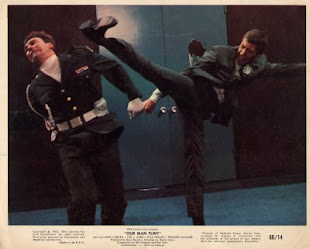
I was introduced to reading at a young age. There is no way of confirming this for certain, but the first book I can remember thumbing through was Alex Haley's 'The Autobiography of Malcolm X'. . .when I was 4 years old.
I did not have the pleasure of growing up (initially) in a household that included the works of
Theodor Geisel, like so many of you. Scholarship (not education) was bald, robust and omnipresent.
Eventually I started school and, in second grade, got introduced to "books for my age group." These books were bequeathed to me via a new program, Reading Is Fundamental (
R.I.F.), designed to inspire reading in the very youngest of Americans by giving them a wide range of books to choose from (literally thousands for each age group), then allowing us to choose two books free of charge every couple of months.
I can recall the great joy of flipping the pages of that
R.I.F. catalogue staring at the myriad assortment of fascinating reading choices, and the agonizing process of elimination, to get my choices down to just two.
Even worse were the annual visit from the
R.I.F. Vehicle Days, when the choices came not from a catalogue, but instead a semi-trailer, outfitted as a rolling library. 10 children at a time would be allowed on the bus, for 10 minutes, to make their two book choices. The way I described the experience to my son Sabik was, "It's like accidentally running into God while walking down the street and having 10 minutes to decide which two questions to ask." I always left the mobile library unit satisfied, but far from content. For who knew how much I left back there?
My affinity for reading comes out of these dual traditions, of serious reading at home and leisure reading at school. It carries through to this day in that, the things I "have" to read for work, others or because of cultural relevance are much lighter than what I read for personal pleasure. And each year, I would say, I read between 50-75 books. Not quite the torrid pace of my mid-twenties, when I easily read 100-150 books per. But hey, old bones, alcohol and smoke-machines catch up to even the best of us.
Books are in the news in a very big way right now. Did Joanne Murray pen another Harry Potter tome? Did some abandoned parish in England collapse, only to discover an unpublished work from the Bard of Avon? No and, ehh, NO! Sarah Palin has 'Gone Rogue.'
If you type the word "book" in Google's news aggregation page, the first 1,610 returned queries will be for the "Barracuda" herself, Mrs. Palin. This normally would not bother me, because I believe book readers are a dying breed. The problem I have with the coverage, response to and the book of Mrs. Palin is, it PROVES book readers are a dying breed!
None of the coverage is about the book itself, it is only about the former Governor's magnetism. The book itself, much like her vice-presidential qualifications 16 month's ago, is an afterthought.
So what we are stuck with is an around the clock Sarah-thon, covered by all four major networks, each of the three major cable-news networks and hundreds of print media, all scrambling and fawning at "her ability to draw a crowd." This has created a news bubble that has easily over-inflated the importance of the book, the woman and the book-signings themselves. Before I burst this bubble and give a few of you liberals the relief you so desperately have been seeking since this farce began, let us examine a few of the headlines since the book tour began:
- Popularity of Palin rising with book tour
- Palin Draws Thousands to Book Signing at Fort Bragg
- Thousands wait hours to meet Sarah Palin
- Thousands line up in Michigan for Palin
- Thousands throng to Palin as she begins book tour
- Thousands wait in line in Fort Wayne for Day 2 of Sarah Palin's 'Going Rogue' book tour
- Palin Supporters Crowd Noblesville Bookstore
and I would be remiss if I left out. . .
- Billy Graham: God was using Palin 'to wake America up'
Which is a sentiment I can agree with, if the statement is taken only at the face value unintended by it's author.
So we are getting round-the-clock, up-to-the-minute, breaking-news updates on this book tour by every media outlet in this country because. . .Sarah has big crowds showing up at her book signings. The first reason to be unafraid by this development is clearly illustrated in the video below. In it you will see the kind of lucid, informed judgement residing in the folks that stand in line for an autograph from "Joe the Sarah."
So, seeing as though none of these interviews or book signings were held in the State of Alaska, each of these people are admitting to being without direction in their life before August 29, 2008, the day Sarah Palin was introduced to the world, as John McCain's Vice-Presidential running-mate.
Everything they had learned up to that point (and whomever they learned it from) was not worthy of stemming the tide of "you-betcha-ness" from America's Hottest Hockey Mom. A scene from "Up," one of the best movies of 2009, comes to mind. In the scene the main characters stumble upon a dog equipped with a collar that allows him to communicate his thoughts with an electronic version of the human voice. While the two humans are amazed by the invention and it's implications for understanding between the two species, the dog's thought process is regularly interrupted by his desire to focus only on chasing squirrels. The point being, sometimes that's all there is to it. For many of these people, Sarah is the new squirrel.
Next, I'd like to question the amount of coverage given to her crowd size. If this much coverage is warranted by "the sheer size of her crowds," as CNN's Andersen Cooper stated last Thursday, where were the media trucks and coverage on any of the following book signings? Feel free to click the links, as they are all real headlines.
and perhaps more in tune with the Palin Tour. . .
There was very little coverage of any of these stories, and appropriately so. Drawing a crowd to a book signing is not that big a deal, it's why they were created. And besides, I'd like to hear Katie Price's views on Cap and Trade. The answer could not be more ridiculous and may prove more interesting.
Last Wednesday, the "Going Rogue Tour" came to Cincinnati. Because of "security concerns" for Mrs. Palin and "overflow concerns" for the anticipated crowd, the bookstore was closed to the public for 6 of the regular business hours. The only people allowed into the store at this time had to have already purchased the book from the store and be in possession of a signing ticket. The books were on sale for 14.00 and 750 tickets were sold, which means they made $10,500 for the day, minus the expenses of printing, marketing, enhanced security and the like.
Borders bookstores, the nations second largest brick-and-mortar book retailer, is operating currently in "Liquidation Mode," as they continue to operate far below the depths of profitability, much to the surprise and guffaws of everyone in the retail industry. If Borders were taking in $10,500 per day, one week before Thanksgiving, at one of it's smallest stores, I'd have to think they'd shoot themselves in the head and abandon hope. So, for many, these book signings by Mrs. Palin are not the financial boon they are made out to be.
I think they are another example of what American Media has manufactured over the past 10-15 years, an escape from the reality of a sucky life.
At a time of record joblessness, record corporate and governmental graft, record foreclosures, record evictions, record governmental secrecy, record media consolidation, record public service cuts, record privatization of the public works, record loss of life due to no access to healthCARE, record reduction in home values, record low test scores for American school children, record violence being committed on those school-kids, record violence against women, record infrastructure problems throughout the country, record budget-busting immigration problems and record lack of leadership on any of these issues, the Sarah Plain (oops! I meant Palin) Tour is a distraction.
A distraction from the reality that America has a leadership problem. From the White house, to the boardroom, to the classroom and extending all the way to the dining room. What lead to this dearth of leaders and leadership, is a complete blackout in developing critical thinking in this country, which too often (at least in this country) is given a name: sedition, trouble-making, boat-rocking, red-personality, loony or rebelliousness.
Americans are for slow, incremental changes to problems that were created by swift, radical swings in the wrong direction. Which is why I am all for America reading more.
By expanding our viewpoint through learning (NOT EDUCATION), we allow ourselves access to new lines of thought with ourselves, previously unavailable.
I have no doubt, no matter how big the problem, the solution to America's issues lie in the bowels of that truck I first encountered 32 years ago. For reading continues to be fundamental!
Post Script:



























